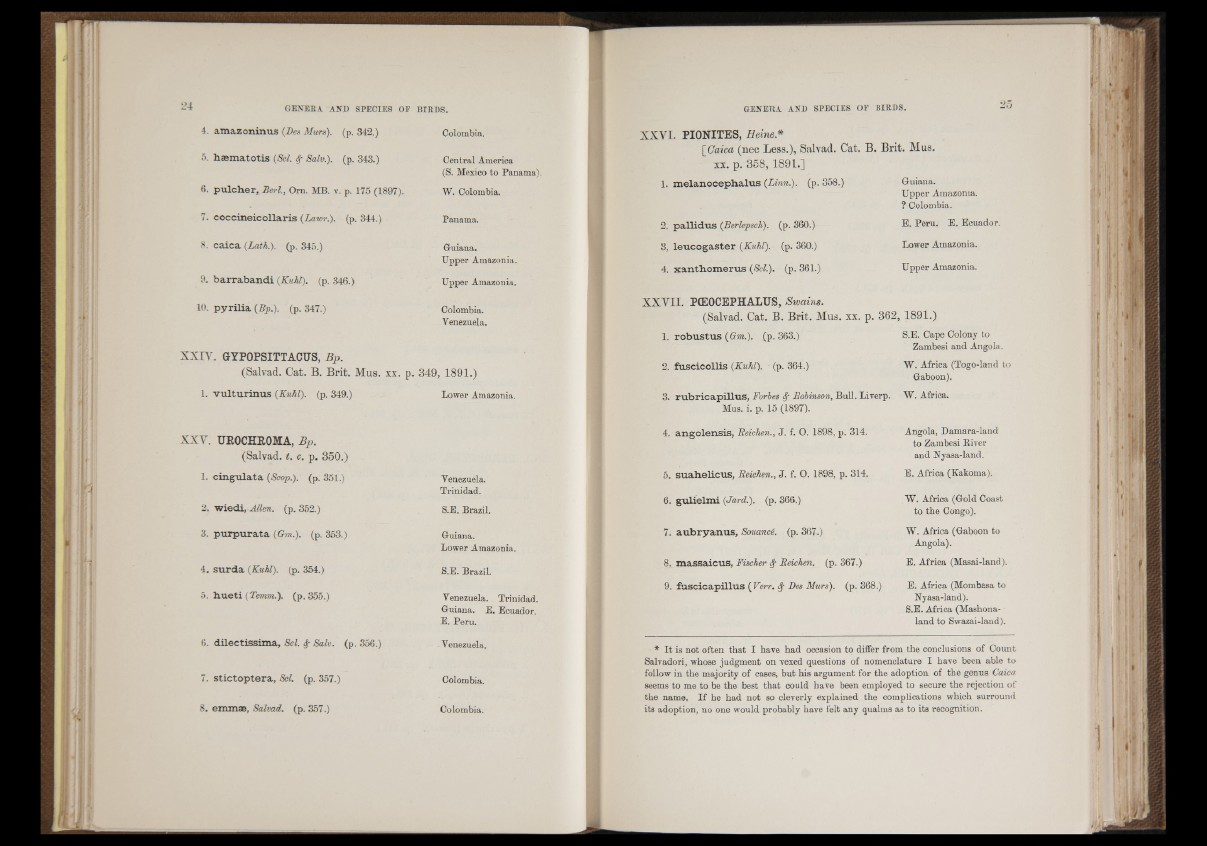
4. amazoninus (Des Murs), (p. 342.) Colombia.
5. hæmatotis (Sci. $ Salv.). (p. 343.)
6. pulcher, Beri, Orn. MB. v. p. 175 (1897).
7. coccineicollaris (Lawr.). (p. 344.)
8. caica (Lath.), (p. 345.)
9. barrabandi (Kuhl). (p. 346.)
10. p y r ilia (Bp.), (p. 347.)
Central America
(S. Mexico to Panama).
W. Colombia.
Panama.
Guiana.
Upper Amazonia.
Upper Amazonia.
Colombia.
Venezuela.
XXIV. GYPOPSITTACUS, Bp.
(Salvad. Oat. B. Brit. Mus. xx. p. 349, 1891.)
1. vultur inus (Kuhl). (p. 349.) Lower Amazonia.
XXV. TJR0CHR0MA, Bp.
(Salvad, t. c. p. 350.)
1. cingulata (Scop.), (p. 351.)
2. wiedi, Allen. (p. 352.)
3. purpurata (Gm.). (p. 353.)
4. surda (Kuhl). (p. 354.)
5. h u e ti (Temrn.). (p. 355.)
Venezuela.
Trinidad.
S.E. Brazil.
Guiana.
Lower Amazonia.
S.E. Brazil.
Venezuela. Trinidad.
Guiana. E. Ecuador.
E. Peru.
6. dilectissima, Sci. Salv. (p. 356.) Venezuela.
7. stictoptera, Sci. (p. 357.) Colombia.
8. emmae, Salvad, (p. 357.) Colombia.
25
XXVI. PIONITES, Heine*
[Gaica (nec Less.), Salvad. Cat. B. Brit. Mus.
xx. p. 358, 1891.]
1. melanocephalus (Linn.), (p. 358.) Guiana.
Upper Amazonia.
2. pallidus (Berlepsch), (p. 360.)
3, leucogaster (Kuhl). (p. 360.)
? Colombia.
E. Peru. E. Ecuador.
Lower Amazonia.
A I iV/i
XXVII. POE0CEPHALTTS, Swains.
(Salvad. Cat. B. Brit. Mus. xx. p. 362, 1891.)
1. robustus (Gm.). (p. 363.)
2. fuscicollis (Kuhl). (p. 364.)
S.E. Cape Colony to
Zambesi and Angola.
W. Africa (Togo-land to
Gaboon).
3. rubricapillus, Forbes $ Robinson, Bull. Liverp. W. Africa.
Mus. i. p. 15 (1897).
4. angolensis, Reichen., J. f. O. 1898, p. 314.
5. suahelicus, Reichen., J. f. O. 1898, p. 314.
6. gulielmi (Jard.). (p. 366.)
7. aubryanus, Souance. (p. 367.)
8. massaicus, Fischer §■ Reichen, (p. 367.)
9. fuscicapillus ( Verr. Bes Murs). (p. 368.)
Angola, Damara-land
to Zambesi Biver
and Nyasa-land.
E. Africa (Kakoma).
W. Africa (Gold Coast
to the Congo).
W. Africa (Gaboon to
Angola).
E. Africa (Masai-land).
E. Africa (Mombasa to
Nyasa-land).
S.E. Africa (Mashona-
landto Swazai-land).
* It is not often that I have had occasion to differ from the conclusions of Count
Salvadori, whose judgment on vexed questions of nomenclature I have been able to
follow in the majority of cases, but his argument for the adoption of the genus Caica
seems to me to be the best that could have been employed to secure the rejection of
the name. If he had not so cleverly explained the complications which surround
its adoption, no one would probably have felt any qualms as to its recognition.